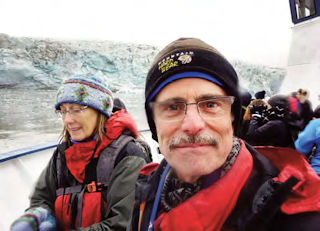SEJournal Online is the digital news magazine of the Society of Environmental Journalists. Learn more about SEJournal Online, including submission, subscription and advertising information.
EJ Academy
By SARA SHIPLEY HILES
 |
|
The upside of teaching journalism? Tom Yulsman of the University of Colorado Boulder and his wife Sylvia Fibich (left), after toasting with vodka served on glacial ice, as they and students visited a fjord on a trip to Svalbard, Norway. Yulsman co-taught a field module on climate journalism offered by Oslo and Akershus University College last September. Photo by Kelsey Ray |
Journalists get called a lot of things: Ink-stained wretch. Newshound. Scribe. Hack. Pencil pusher. Word nerd. Photo geek.
How about “professor”?
To a working journalist, that may sound delightful. Getting away from daily deadline pressures, working in a collegial atmosphere, molding young minds: This is the stuff of which academic dreams are made.
But the ivory tower isn’t idyllic. Low pay, high workloads and the politics of higher education are among the common complaints. So is it right for you?
We crowdsourced questions and answers about the academic life using the SEJ-Talk and SEJ-Edu listservs. More than a dozen SEJ academic members offered their expert advice.
Their wide-ranging discussion revealed, as one member put it, that “Universities are not the temples of reason and collegiality that you might hope for.” But it also showed that teaching may be a satisfying, even inspiring, second career.
Below, we’ve compiled answers to common questions about switching from the newsroom to the classroom. Think of it as an abridged version of the “Truth about Teaching.”
If I want to teach, do I need a Ph.D.?
No. But it does help.
“If you have long and broad experience with a well-regarded media outlet, some departments are willing to hire you with only a bachelor’s degree, but probably as a contract lecturer, not on a tenure track,” says Al Cross, an associate professor and director of the Institute for Rural Journalism and Community Issues at the University of Kentucky.
A master’s degree can lead to better pay and more respect, says Annie-Laurie Blair, a senior clinical professor of journalism at Miami University of Ohio. She has been teaching full time since 2007 after a career in corporate journalism.
Bill Kovarik, a professor at Radford University School of Communication, says a Ph.D. is “a must unless you just want part-time work.” Pursuing one, however, takes several years and sometimes tens of thousands of dollars.
On the other hand, Bernardo Motta, an assistant professor in the Department of Journalism and Media Studies at the University of South Florida St. Petersburg, suggests doing the Ph.D. only if you love academic research. “If not, it might kill you,” he says.
Research institutions or schools that have graduate programs may want a Ph.D., but they also need people who have fresh experience and industry connections. Sometimes another “terminal degree” like a Master of Fine Arts or a law degree will suffice; it all depends on the school.
When Bob Wyss began looking for a teaching job, he had a master’s degree, adjunct teaching experience and a 20-year track record as a journalist, yet he was passed over several times for candidates who had Ph.D.’s. Eventually he found a school that valued his credentials, and soon he will become a full professor of journalism at the University of Connecticut.
“This has been the best job that I have ever had, and the struggle was absolutely worth it,” he says.
What types of academic jobs are out there?
It starts with the lowly adjunct instructor. These are one-off positions, usually hired to teach a particular class for a particular semester. It can work for journalists who like to teach on the side and earn some extra cash, perhaps $4,000 per semester. It can also be a foot in the door to a new career.
But being a full-time adjunct stinks. It’s been compared to “slave labor,” or more charitably, a “volunteer job.” At some universities, adjuncts are unionizing in hopes of earning living wages and benefits.
Some journalists have been hired as instructors or lecturers in the $30,000-$60,000 salary range plus benefits. These teaching-oriented positions may come with multi-year contracts. Other common titles are “professor of practice” or “extension professor,” which may be tied to university newsroom work or professional training programs.
At the top of the heap are tenure-track positions, with salaries reported in the $40,000-$90,000 range (and sometimes much higher for wealthy institutions in certain markets). These often, though not always, carry the expectation of a Ph.D. and significant academic research responsibilities.
Tenure offers some job security, but getting there is an exhausting, multi-year slog. Just ask Tom Yulsman, a professor of journalism and director of the Center for Environmental Journalism at the University of Colorado Boulder. He attained tenure and full professor status without a Ph.D., but he (sort of) jokes the process nearly put him in the hospital. “Did I mention that this was hard?” he says.
Course loads vary from one to four classes per semester, depending on the assigned mix of classroom teaching, academic research, creative work, administration and service. Sixty-hour work weeks aren’t unusual. Then again, for those on a nine-month appointment, summers are off!
What’s teaching really like?
Let’s take the challenges first. Part of the job is not about teaching journalism. There’s a learning curve “that has little to do with writing and reporting and a whole lot to do with educational psychology, academic culture and Adjust Your Expectations 101,” says Meg Turville-Heitz, a lecturer in technical communications at the University of Wisconsin - Madison.
For example, how would you handle a student who tells you about a sexual assault? Academics have to navigate that and more. Students who seem lazy or unprepared are a bane. Some need remedial work, although many journalism classes are electives that attract more dedicated students.
Grading is the biggest dislike by far. Critiques and editing are time-consuming when you have 20 assignments to read at once. “Helping good writers become great ones is incredibly satisfying,” Yulsman says. “Helping bad ones realize that they should choose another career is not nearly so.”
Teaching “likes” start with the students who get inspired: “I love mentoring. I love seeing the light come on. I love seeing some of these really brilliant kids just grab the bit and go,” Turville-Heitz says. “I love when students tell me I’ve inspired them to pursue a particular direction in their career, or ask me for advice or help in their careers.”
Adventure — both intellectual and in-real-life — is another bonus. Blair has gotten to teach in Costa Rica and Italy, and to develop a course for science master’s and Ph.D. students. “Love. It. All,” she says. “I’m more alive today than I was working for a newspaper.”
Kovarik says: “The day-to-day work is to be alive to the world of ideas and to strategically advance the best. And you can do that without deadline pressures, which is cool.”
 |
|
Two U.S. journalism students walking down the Longyear Glacier on their way back down to the town of Longyearbyen in Svalbard. They were there as part of a course on climate journalism offered in Norway last fall. Photo: © Tom Yulsman |
How do I get started in teaching?
Want a test drive? Contact faculty members you know and volunteer to do guest lectures. This shows you how classrooms operate, Cross says. Seek mentoring from faculty members who can help you break down what to teach and how to do it effectively.
You can also try team-teaching with a more experienced instructor. Douglas Fischer, director of Environmental Health Sciences, which publishes the websites EHN.org and DailyClimate.org, co-teaches a course at Montana State about climate science and policy. “Team-teaching allows me to observe some veterans in the classroom. It’s a lot of work, but the fun in the end outweighs the work, as we keep re-upping,” Fischer says.
If you get offered an adjunct teaching gig, quickly reach out to other professors for suggested assignments, textbooks, grading rubrics and syllabi. SEJ, the Poynter Institute and Journalists’ Resource all offer sample syllabi online. Attend faculty meetings and sit in on other classes, even if you don’t have to.
Consult with other part-time-faculty friends for practical advice. For example, working journalists may get called out on a breaking news assignment in the middle of class. “Keep a tickler list of friends and colleagues who might be able to sub for you on short notice,” suggests Eric Freedman, professor and Knight Chair in Environmental Journalism at Michigan State University.
For those who hope to move from adjunct to full time, Cross suggests getting to know department chairs and deans. “Make your intentions clear and learn what you need to do to qualify and compete,” he says. From there, build a specialty or interest area that will make you stand out.
Is there a money-back guarantee?
Nope. Some love teaching, and some actually leave it to go back to journalism. The pay can be low, academic politics can be tricky and funding can be unstable as higher ed goes through its own disruptions.
Each academic institution is different, and each teaching position is different. The United States has more than 4,000 institutions of higher education, ranging from small private schools and community colleges to big research universities and elite Ivys, points out Bruce Lewenstein, chair of the Department of Science & Technology Studies at Cornell University. Journalists who are ready to navigate a career change or who simply want a change of pace will find many options.
Bottom line: Do what you like, and find a program that likes what you do.
“My experience has been completely different from everyone else’s on this [email] string,” says Dan Fagin, director of the Science, Health and Environmental Reporting Program at New York University. “Your results not only may vary, they WILL vary. This is the best job I’ve ever had in my life, and I’ve had some very good ones. But that is entirely due to unique circumstances. This field is very, very diverse.”
Sara Shipley Hiles is a former full-time journalist who began teaching adjunct ten years ago. She is now an assistant professor at the University of Missouri School of Journalism. She is also editor of SEJournal’s “EJ Academy” column.
* From the quarterly news magazine SEJournal, Summer 2016. Each new issue of SEJournal is available to members and subscribers only; find subscription information here or learn how to join SEJ. Past issues are archived for the public here.













 Advertisement
Advertisement 



